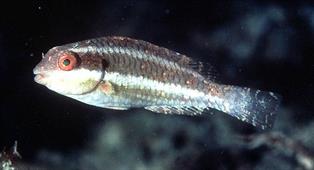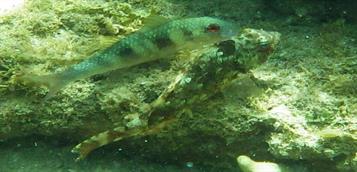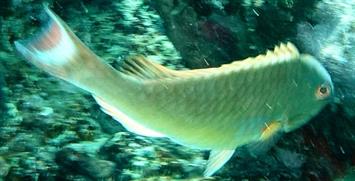



Sparisoma chrysopterum
| Ecological Descriptors |
||||
| Habitat | Size (cm) | Diet | Behaviour | Sex |
| Co, S | 45 | Veg | I | F (PGH?) |
General:
Parrotfish owe their name to the shape of their mouth. Instead of teeth they have two beak-like plates, like parrots. They have even rows of large, noticeable scales on their bodies.
Description:
Terminal phase:
Terminal phase: Blue green and paler bluish below. Pectoral yellow with a black blotch on upper base plus a large elongate blue blotch on side behind pectoral base. Tail with blue-areen base, a brownish C shaped bar from tail tips through center of fin. A yellowish bar behind and below that and a red crescent at the end of the fin. Concave tail margin.
Initial phase: Grey brown to reddish brown, but can rapidly change colour, (similar to Yellowtail Parrotfish, (S. rubripinne)) to pale grey or mottled dark with pale patches. The scales on belly and chest can have red spots and with a dark blotch at upper pectoral base (as does Yellowtail Parrotfish). Tail dark base, pinkish to red at rear, upper and lower borders barred. Difficult to distinguish in some colourations from the Yellowtail Parrotfish (S. rubripinne).
Juvenile phase: When very small, body dark reddish brown with three rows of widely spaced white spots. Belly lighter and a white bar on the tail. Almost indistinguisable visually from Stoplight and Yellowtail Parrotfishes, although Stoplights retain spots for far longer..
Ecology
This species is found in reef and seagrass habitats from 2-20m (6 to 70ft) depth, though usually deeper in general than the Yellowtail Parrotfish (S. rubripinne). It occurs in coral and rocky reefs, and adjacent habitats, the young especially in seagrass beds. Juveniles or primary-phase adults rapidly assume a mottled pattern and blend with the substratum when they come to rest on the bottom. It feeds on benthic algae and seagrass, although may also eat sponges.
Life Cycle:
Generally believed to be protogynous sequential hermaphrodites like all Sparisoma spp, although this had been contested by some in the past. Hence all are born female and a relatively small portion of the population sexually differentiate into males upon reaching sexual maturity, however many females of the population remain female.
Mating occurs In territories with a TP male co-existing with several females which make up a harem. It is suggested that the larger males in multi-male territories have an advantage in reproductive success as well having a crucial role of protecting the territory as they tend to be more aggressive.
They are pelagic spawners which produce and release free floating, buoyant eggs into the water which settle onto the underlying coral. Fertilization of eggs occurs externally with no indication of direct parental care, however groups of the largest males in the territory fiercely defend spawning sites. Lives for at least 5 years.
Parrotfish owe their name to the shape of their mouth. Instead of teeth they have two beak-like plates, like parrots. They have even rows of large, noticeable scales on their bodies.
Description:
Terminal phase:
Terminal phase: Blue green and paler bluish below. Pectoral yellow with a black blotch on upper base plus a large elongate blue blotch on side behind pectoral base. Tail with blue-areen base, a brownish C shaped bar from tail tips through center of fin. A yellowish bar behind and below that and a red crescent at the end of the fin. Concave tail margin.
Initial phase: Grey brown to reddish brown, but can rapidly change colour, (similar to Yellowtail Parrotfish, (S. rubripinne)) to pale grey or mottled dark with pale patches. The scales on belly and chest can have red spots and with a dark blotch at upper pectoral base (as does Yellowtail Parrotfish). Tail dark base, pinkish to red at rear, upper and lower borders barred. Difficult to distinguish in some colourations from the Yellowtail Parrotfish (S. rubripinne).
Juvenile phase: When very small, body dark reddish brown with three rows of widely spaced white spots. Belly lighter and a white bar on the tail. Almost indistinguisable visually from Stoplight and Yellowtail Parrotfishes, although Stoplights retain spots for far longer..
Ecology
This species is found in reef and seagrass habitats from 2-20m (6 to 70ft) depth, though usually deeper in general than the Yellowtail Parrotfish (S. rubripinne). It occurs in coral and rocky reefs, and adjacent habitats, the young especially in seagrass beds. Juveniles or primary-phase adults rapidly assume a mottled pattern and blend with the substratum when they come to rest on the bottom. It feeds on benthic algae and seagrass, although may also eat sponges.
Life Cycle:
Generally believed to be protogynous sequential hermaphrodites like all Sparisoma spp, although this had been contested by some in the past. Hence all are born female and a relatively small portion of the population sexually differentiate into males upon reaching sexual maturity, however many females of the population remain female.
Mating occurs In territories with a TP male co-existing with several females which make up a harem. It is suggested that the larger males in multi-male territories have an advantage in reproductive success as well having a crucial role of protecting the territory as they tend to be more aggressive.
They are pelagic spawners which produce and release free floating, buoyant eggs into the water which settle onto the underlying coral. Fertilization of eggs occurs externally with no indication of direct parental care, however groups of the largest males in the territory fiercely defend spawning sites. Lives for at least 5 years.
Redtail Parrotfish TP
Redtail Parrotfish transition to TP


Redtail Parrotfish Juvenile
(C) JE Randall

Redtail Parrotfish IP
Redtail Parrotfish IP

185
186
187




205
Redtail Parrotfish IP






616

